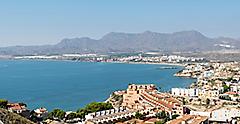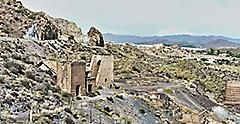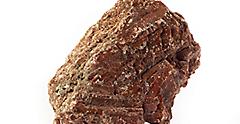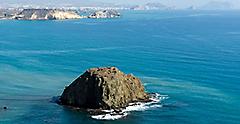Traveling To The Crystal Caves In Spain: Spelunking For Geodes
Spain Caving Vacation Adventure.
By Eben Diskin | Published on April 18, 2022
When you think of Spain, your mind is probably flooded with colorful visions of its beaches, Moorish architecture and the flowing dresses of flamenco dancers. Or maybe you're imagining Pamplona's famous "Running of the Bulls" or craving a delectable spread of tapas with a side of sangria. What might not immediately come to mind is traveling to the magical crystal caves in Spain. The Pulpí Geode is one of the most surreal crystal caves not only in Spain but in the entire world.
The caves are remarkable for both their size and the perfection of the crystals found inside, many of which are the size of a grown man. From its initial discovery in the abandoned Mina Rica mine, the tale of the Pulpí Geode isn't one of a typical, ages-old tourist attraction. It's pure adventure — and it should be a focal point of your next Spain travel experience.

Discovering The Magical Geode From The Crystal Caves In Spain

How Was The Pulpí Geode Formed?
Crystals typically form when liquids cool and harden. In Pulpí, the crystals are believed to have formed at 68 degrees Fahrenheit just below the surface, which caused the gypsum minerals there to dissolve and eventually recrystallize over thousands of years. Due to the purity of the crystals, the research team has been unable to accurately determine their date of origin, though they estimate their age to be between 60,000 and two million years old.
Despite the ongoing mystery, scientists believe the crystals formed through a process called Ostwald ripening, where large crystals are created from the dissolution of smaller ones. However old it might be, the Pulpí Geode is one of the most magical geological features in all of Spain.
What's Actually In A Geode Rock, Anyway?


As you are spelunk through the Spanish cave, you'll notice the crystals' stunning aesthetic. This is largely thanks to the gypsum that they're made from. Gypsum is composed of water and calcium sulfate, which gives the crystals their sparkling, transparent look. However, compared with other geodes, Pulpí still remains somewhat of a mystery. A similar geode was discovered 1,000 feet beneath the town of Naica in the Mexican state of Chihuahua. The Naica geode also houses a cavern of gypsum crystals, but those crystals were still in the process of growing when it was discovered, so researchers had an easier time dating them and learning about their history. The Pulpí Geode, by contrast, is completely dry, meaning its crystals haven't grown in tens of thousands of years. Since the crystals don't contain enough uranium isotopes, scientists aren't able to accurately perform radiometric dating.
Though once off-limits to visitors, the Pulpí Geode is now open to tourists traveling to Spain for vacation thanks to the mapping efforts of the research team. Since gypsum is incredibly fragile, the crystal cave is now protected and preserved with a glass shield.
Guided tours of the geode are available, though finding tours in English may be challenging. If you don't speak Spanish, you can ask for an English tablet, which you can use to listen to educational modules about the history of the mine and its minerals as you walk through. Once you're in the mine, you'll have to walk 196 feet to reach the geode. That might not sound very far, but the journey actually requires you to descend into the tunnels, climb a set of stairs into a hole in the rocks and squeeze through a corridor of jagged crystals to access the geode. It might be a little uncomfortable, but it's worth it. Your efforts will be rewarded once you make your way into the geode and you find yourself in another world surrounded by dazzling crystals.
Be aware that it's necessary to climb a metal spiral staircase of approximately 170 steps to reach the geode, so those with mobility issues, claustrophobia or heart and lung problems are advised to think twice before making the journey.
Things To Do In Pulpi, Spain: Traveling Beyond The Cave


For a slightly more relaxing way to unwind after squeezing through the crystal caves, just drive 15 minutes to one of the area's many beaches. The beaches of La Entrevista, Los Nardos, San Juan de los Terreros, Mar Serena, Mar Rabiosa and Los Cocedores are all within driving distance. If you still haven't had your fill of caves and spelunking, Los Cocedores beach — on the border between Murcia and Almeria — actually has a variety of sea caves you can visit. And don't worry, you won't even have to crawl underground to see them. The caves lend the area such a unique aesthetic that the beach has even served as a filming location for several movies.
You could plan an entire travel vacation around caving in Spain. It's a thrilling adventure to another world, where you can learn about what was here before us and, perhaps, discover something new for yourself.





